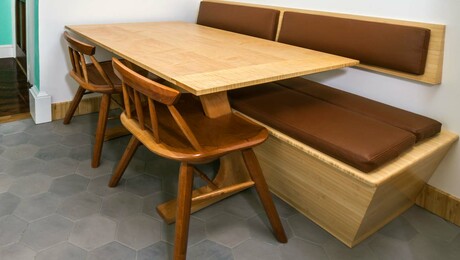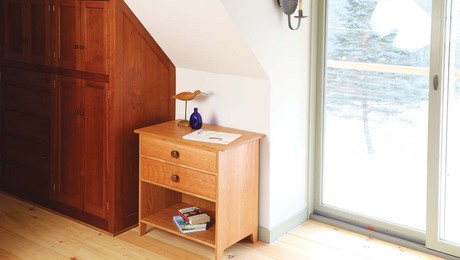How to make a knuckle joint
Steve Latta demonstrates how to create a knuckle joint, the heart of a period drop leaf table.Sticking with precedent, I use a five-knuckle layout, the triple knuckle fixed to the inner apron and the double knuckle cut on the swing arm. I mill the stock at least a few inches longer than necessary to provide options should life happen when I’m not paying attention. Each knuckle joint starts with two blanks, 3⁄4 in. thick by 45⁄8 in. wide by 14 in. long. Ideally, I’ll cut each pair from a longer board for continuity. But this is not the place to use pretty stock. Function takes precedence and nice, straight grain is the ticket.
Set up a router table with a 3⁄8-in. roundover bit and, for safety, accuracy, and to minimize tearout, use a fence and a push block. I rout the profile on both ends of each workpiece, using a four-to-get-two approach: I’ll cut knuckles on all four ends and pick the best two when they are fitted together. By “best” I mean both tight and clean.
After sanding the roundover, put a 3⁄4-in.- dia. circle template at the end of the board and trace the circle, locating the center point within it. Then run a 45° line through the center out to the show face. Doing so creates a small triangular area that you’ll remove on the router table with a 90° V-bit. After routing, fair one side of the V-groove to a curve with a chisel and sandpaper.
I made a pair of gauge blocks for laying out the knuckles. Once those lines are scored, excavate between the knuckles on the tablesaw using a carriage jig and a 1⁄2-in. dado set. Mounted to two miter gauges, the carriage both secures the work and provides a positive reference for both sides of each notch. Having notched all the pieces, try all combinations until you get two sets with the tightest fit free of gaps.
Once the knuckle spacing is cut, you have to scoop out extra material at the base of the notches to accommodate the curves as the joined pieces swing. When both pieces fit together completely with a small gap, the excavating is complete. Secure the joints with a few strips of clear, 2-in. packing tape on both sides. The tape will prevent the pieces from sliding when you drill for the 3⁄16-in. pin.
Drilling for the pin
To get a true hole, it’s best to drill in from both ends. Make a fence the length of your drill-press table, around 11⁄2 in. thick and 3⁄4 in. wider than the swing arm. One end of the fence must be square and perpendicular to the table. Set the fence so the tip of a 3⁄16-in. brad-point bit is centered on the knuckle joint. (To reduce the likelihood of drift, don’t use a standard twist drill bit.) Make an auxiliary table from 3⁄4-in. MDF that is the length of your fence and about 21⁄2 in. wide. Use a spacer to elevate the auxiliary table 3 in. or so above the main table. Align one end of the auxiliary table to the square end of the fence, and bore a 3⁄16-in. hole through the MDF. Remove the spacer and, keeping the auxiliary table aligned to the end of the fence, clamp it to the main table. Following these steps guarantees the hole is in direct alignment with the bit.
To bore the first half of the hole, line up the center point of the knuckle with the brad point, clamp the stock to the fence, and drill a little more than halfway through the joint. A registration pin will position the workpiece to cut the rest of the hole. Cut a 1-in. length of 3⁄16-in. steel rod and round each end on the grinder. Insert the pin into the hole in the auxiliary table and place the drilled portion of the knuckle joint over the pin. After double checking to make sure the same face is against the fence, clamp the workpiece and bore the second hole. Having cut scores of these, I still get a sense of relief when the bit meets the first hole.
Cut another length of rod to just under the full width of the apron. Gently hammer it in from the bottom to reduce blowout. At this point, the hinge should work nicely with a little bit of sanding.






















Comments
What a great video! It was interesting and informative.
Mr. Latta's intelligence, experience. and craftsmanship are evident in every step.
Thanks!
Complexity made with Simplicity...one step at a time.....Thanks for sharing...
This is way more complex to make than I expected.
Nice work! It is unfortunate that the hidden gems like the Knuckle Joint will not be seen once the table is completed unless you have a nosey wood craftsman that turns the table upside down. Would a wood pin of hard maple work as well?
Thanks
Log in or create an account to post a comment.
Sign up Log in